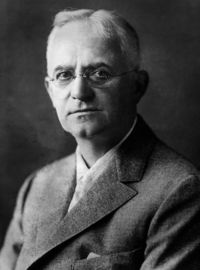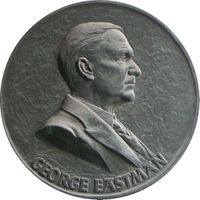George Eastman
| George Eastman | |
|---|---|
 |
|
| Born | July 12, 1854 , U.S. |
| Died | March 14, 1932 (aged 77) , U.S. |
| Resting place | Ashes buried at Kodak Park |
| Nationality | American |
| Occupation | Businessman, inventor, philanthropist |
| Known for | Photography pioneer, Founder of Eastman Kodak |
| Parents | George Eastman (1815-1862) & Maria Kilbourn (1821-1907) |
George Eastman (July 12, 1854 – March 14, 1932) founded the Eastman Kodak Company and invented roll film, helping to bring photography to the mainstream. Roll film was also the basis for the invention of motion picture film in 1888 by the world's first filmmaker Louis Le Prince, and a few years later by his followers Léon Bouly, Thomas Edison, the Lumière Brothers and Georges Méliès.
He was an American inventor and philanthropist, who played a leading role in transforming photography from an expensive hobby of a few devotees into a relatively inexpensive and immensely popular pastime.
Contents |
Early life
He was born in Waterville, New York, and was self-educated. In 1884, Eastman patented the first film in roll form to prove practicable; in 1888 he perfected the Kodak camera, the first camera designed specifically for roll film. In 1892, he established the Eastman Kodak Company, at Rochester, New York, one of the first firms to mass-produce standardized photography equipment. This company also manufactured the flexible transparent film, devised by Eastman in 1889, which proved vital to the subsequent development of the motion picture industry.
Eastman was associated with the company in an administrative and an executive capacity until his death and contributed much to the development of its notable research facilities. He was also one of the outstanding philanthropists of his time, donating more than $75 million to various projects. Notable among his contributions were a gift to the Massachusetts Institute of Technology and endowments for the establishment of the Eastman School of Music in 1918 and a school of medicine and dentistry in 1921 at the University of Rochester.
Later years
In 1925, Eastman gave up his daily management of Kodak to become chairman of the board. He thereafter concentrated on philanthropic activities, to which he had already donated substantial sums. For example, he donated funds to establish the Eastman Dental Dispensary, in 1916. He was one of the major philanthropists of his time, ranking only slightly behind Andrew Carnegie, John D. Rockefeller, and a few others, but did not seek publicity for his activities. He concentrated on institution-building and causes that could help people's health. He donated to the University of Rochester, establishing the Eastman School of Music and School of Dentistry; to Tuskegee Institute; and to the Massachusetts Institute of Technology (MIT), donations that provided the capital to build several of their first buildings at their second campus along the Charles River.
In his final two years, Eastman was in intense pain, caused by a degenerative disorder affecting his spine. He had trouble standing and his walking became a slow shuffle. Today it might be diagnosed as spinal stenosis, a narrowing of the spinal canal caused by calcification in the vertebrae. Eastman grew depressed, as he had seen his mother spend the last two years of her life in a wheelchair from the same condition. On March 14, 1932, Eastman committed suicide with a single gunshot to the heart, leaving a note which read, "My work is done. Why wait?"[1] His funeral was held at St. Paul's Episcopal Church in Rochester; he was buried on the grounds of the company he founded at Kodak Park in Rochester, New York.
Legacy

During his lifetime, he donated $100 million, mostly to the University of Rochester and the Massachusetts Institute of Technology (under the alias "Mr. Smith").[2] The Rochester Institute of Technology has a building dedicated to Mr. Eastman, in recognition of his support and substantial donations. He endowed the Eastman School of Music of the University of Rochester.
In recognition of his donation, MIT has a plaque of Eastman (the rubbing of the nose of which is traditionally considered by students to bring good luck). Eastman also made substantial gifts to the Tuskegee Institute and the Hampton Institute. Upon his death, his entire estate went to the University of Rochester, where his name can be found on the Eastman Quadrangle of the River Campus. The auditorium at Mississippi State Universities Dave C. Swalm School of Chemical Engineering is named for Eastman in recognition of his inspiration to Mr. Swalm. His former home at 900 East Avenue in Rochester, New York was opened as the George Eastman House International Museum of Photography and Film in 1949. In 1954, the 100th anniversary of his birth, Eastman was honored with a postage stamp from the United States Post Office. In the fall of 2009, an eight foot tall statue of Eastman was erected on the Eastman Quad of the University of Rochester to commemorate him further.
Eastman had a very astute business sense. He focused his company on making film when competition heated up in the camera industry. By providing quality and affordable film to every camera manufacturer, Kodak managed to turn its competitors into de facto business partners.
In 1926, George Eastman was approached by Lord Riddell, the Chairman of Royal Free Hospital, to fund a dental clinic in London. He agreed to give £800,000 which was matched by £80,000 each from Lord Riddell and Sir Albert Levy, the Royal Free's honorary treasurer.
The Eastman Dental Clinic was opened in November 20, 1931, by the American Ambassador in the presence of Neville Chamberlain. The building, which resembled the Rochester Dispensary, was totally integrated into the Royal Free Hospital and included three wards for oral, ear, nose, and throat and cleft lip and palate surgery and was dedicated to providing dental care for children from the poor districts of central London.[3]
In a similar manner, Eastman went on to establish dental clinics in Rome, Paris, Brussels and Stockholm.[4]
See also
- Eastmaninstitutet
- George Eastman House
References
- ↑ - History of the Eastman Dental Institute (2007) eastman.ucl.ac.uk
- ↑ http://urmc.rochester.edu/dentistry/education/library/history/european-clinics.cfm
Books
- Carl W. Ackerman, George Eastman: Founder of Kodak and the Photography Business (1930), Beard Books, ISBN 1-893122-99-9
- Elizabeth Brayer, George Eastman: A Biography (1996), John's Hopkins University Press, ISBN 0-8018-5263-3, University of Rochester Press 2006 reprint: ISBN 1-58046-247-2
External links
- George Eastman archive at the University of Rochester
- George Eastman at Find a Grave
- The George Eastman House
- Eastman Dental Institute
- Eastman Institute for Oral Health, Rochester, NY
Patents
{TIFF format images}
- U.S. Patent 226,503 "Method and Apparatus for Coating Plates", filed September 1879, issued April 1880
- U.S. Patent 306,594 "Photographic Film", filed March 1884, issued October, 1884
- U.S. Patent 317,049 "Roll Holder for Photographic Films", filed August 1884, issued May 1885
- U.S. Patent 388,850 "Camera", filed March, 1888, issued September, 1888
| Business positions | ||
|---|---|---|
| New office | Treasurer of Eastman Kodak 1884 – 1921 |
Succeeded by |
| Vacant
Title last held by
Henry A. Strong |
President of Eastman Kodak 1921 – April 7, 1925 |
Succeeded by William G. Stuber |
| Awards and achievements | ||
| Preceded by Raymond Poincaré |
Cover of Time Magazine March 31, 1924 |
Succeeded by George V |